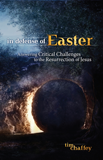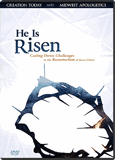Resurrection—No Doubt About It
Biblical History
Christ’s Resurrection is the most mocked and vilified miracle in the annals of human history. “Impossible, a fake,” modern scholars say. Yet a closer examination confirms the Bible’s historical integrity.
Do not be afraid, for I know that you seek Jesus who was crucified. He is not here; for He is risen, as He said. (Matthew 28:5–6)
Unlike many world religions, Christianity’s origins are not shrouded in an unwitnessed, mythical past. The Christian faith centers on the person and work of Jesus Christ. His life and miracles were witnessed by thousands, and His sacrificial death on the Cross was also a public spectacle. Three days later, God raised His Son from the dead, and over the next forty days, Jesus appeared to hundreds of individuals.
Overstating the importance of the Resurrection is impossible. It conclusively demonstrated Christ’s power over the grave, secured our hope of eternal life, and proved that He truly was and is the Son of God. Because He rose, Christ also proved that every non-Christian belief system is false, and that He will eventually return to judge this world (Acts 17:30–31).
So it’s no surprise that people have tried to deny the historic reality of the Resurrection. The attacks began the day of the miracle (Matthew 28:11–15) and have continued until the present day, from the Jesus Seminar to the recent “Jesus myther” fad. The ongoing assaults demonstrate that nobody has found a workable alternative. The biblical and historical evidence is just too overwhelming.1
Is There Evidence That Jesus Rose From the Dead?
The greatest proof of the Resurrection available today is the Bible, which consists of historical documents inspired by God Himself (2 Timothy 3:16). His infallible Word tells us in no uncertain terms that Jesus rose from the dead (Matthew 28:6). As such, we can have complete confidence in this fact.
If someone rejects the Bible’s authority, that person must still contend with the fact that multiple, reliable historical documents make these amazing claims. And based on evidence within the Bible itself, there is no reason to reject those claims. Even most secular historians have come to accept the evidence used in defense of Christ’s Resurrection, though they strive to reach a different conclusion about its significance.
Testimony of Jesus Christ
Consider the testimony of the people recorded in the Bible. First is Jesus Christ Himself. He claimed to be the sinless Son of God, and He prophesied He would rise from the dead on the third day (Matthew 20:19)—a prophecy also hinted at in the Old Testament (Psalm 16:10; Isaiah 53:8–10). Since the Son of God cannot lie, it was impossible for such a person to remain in the grave.
Many Infallible Proofs
Jesus made sure that others saw Him so that they could confirm the reality that He lived again. Luke explains that Jesus “presented Himself alive after His suffering by many infallible proofs
” (Acts 1:3). What could possibly qualify as an “infallible proof” that someone rose from the dead? Luke answers that question: Jesus was seen and heard by the apostles over the course of forty days; He even ate with them, demonstrating that He wasn’t a ghost (Luke 24:37–39).
Scripture mentions at least ten post-Resurrection appearances of Jesus, many of which are listed in 1 Corinthians. Jesus appeared separately to Paul, Peter, James, the rest of the apostles, and over five hundred brethren at once (1 Corinthians 15:5–9). Most of these people were still alive when Paul wrote these words, implying that his readers could check with these witnesses if they didn’t take his word for it.
Even most modern critical scholars acknowledge that Paul heard this message within just a few years of the Resurrection. Given the limited time between the event and the widespread sharing of it, many critics admit that it was not a legend developed over decades but must be traced back to the disciples’ early preaching.
Conversion of Skeptical Witnesses—James and Paul
The Lord’s appearances to James and Paul are especially relevant to historians. Critics have often alleged that the original disciples were in such a malaise that they simply had hallucinations. This proposal is wracked with its own problems, and it still fails to account for Christ’s later appearances to James and Paul.
James was the half-brother of Jesus, and he remained a skeptic throughout the Lord’s earthly ministry (John 7:5). At one point, he and his kin claimed that Jesus was “out of His mind” (Mark 3:20–21). While on the Cross, Jesus entrusted the care of His mother to His disciple John rather than one of His half-brothers, indicating that James likely had not yet come to believe. Yet soon after Jesus ascended to heaven, James was counted among the believers (Acts 1:14), and became a leader in the Jerusalem church (Galatians 2:9). What could account for this dramatic change? In all likelihood, he was convicted of his unbelief and believed in Jesus after seeing Him alive following His execution.
Paul is just as formidable a witness to the Resurrection. He was not a blind follower but the early church’s most feared persecutor. Yet after confronting the risen Lord, Paul was transformed into perhaps the most influential Christian in history. He endured tremendous persecution, including imprisonments, floggings, beatings, and even stoning for his faith. The only plausible explanation for Paul’s changed life was his encounter with the risen Savior on the road to Damascus (Acts 9:1–9).
Fearful to Fearless
Christ’s appearances to His original disciples led to another evidence for the Resurrection—the transformed lives of these frightened men. When Jesus was arrested, they fled for their lives. Yet less than two months later, they boldly proclaimed the Resurrection in front of thousands of Jews (Acts 2:23).
Peter was imprisoned multiple times, yet he continued preaching about the risen Lord until his martyrdom. According to tradition, all the disciples except John were martyred. The only reasonable explanation for this transformation is precisely what the Bible teaches—they knew Jesus had died but saw Him alive again (and were filled with the Holy Spirit).
The Empty Tomb
The fact that Christ’s body was no longer in the tomb is also consistent with the Bible’s claim that He rose. Even the soldiers assigned to guard the tomb and the chief priests admitted it was empty, leading the Jews to concoct a lie that the body was stolen (Matthew 28:11–15). A marble tablet, now in France’s National Library, indicates that the news of the stolen body had reached all the way to the Roman emperor (presumably Claudius) within about a decade of the Resurrection. This tablet, discovered in the late 1870s and dubbed “The Nazareth Inscription,” prescribed a death sentence on anyone caught moving bodies from a tomb. It was not against typical grave robbers who stole valuables, but against body-stealers. The inscription specifically mentions sepulcher-sealing stones, which were used only in Israel.2
The only event in Israel that could reasonably explain such a decree is the lie concocted by the Jewish leaders. Thus, this tablet corroborates Matthew’s account of these events.
The Existence of the Church
The reality of the Resurrection was central to the message the apostles preached. The book of Acts, almost universally recognized as reliable history of the period, claims that these men spoke about the Resurrection repeatedly (Acts 2:23–24, 3:14–15, 4:10–12, 4:33, 5:30–31, and so on). So, contrary to the claims of many skeptics, the Resurrection was not some doctrine dreamed up over decades or centuries by power-hungry church leaders. Even modern secular scholars acknowledge that the Resurrection was the very heart of the church’s message from the start.
Principle of Embarrassment
Modern historians recognize another fact that helps to authenticate the biblical accounts of the Resurrection: the “principle of embarrassment.” Why would writers of history invent details that do not seem to help their cause? For example, the first eyewitness of the risen Savior was not an important dignitary like Caiaphas, Pilate, or King Herod; nor was it a leading disciple like Peter or John. Instead, it was a woman. And not just any woman, but Mary Magdalene, a woman from whom Jesus had cast seven demons (Luke 8:2).
Why would the Gospels claim that Mary was the first witness when a woman’s testimony, let alone a former demoniac, was not highly valued in first-century Israel? Either the writers were quite foolish or exceedingly clever, or they wrote precisely what happened.
Changed Hearts in Later Generations
Ephesians 3:17 explains that Christ dwells in the hearts of believers. Christians throughout history have testified to the significant changes that the risen Savior has worked in their lives. Unbelievers may scoff at such anecdotal evidence, but genuine believers know beyond any shadow of a doubt that their Lord is alive and well because they have experienced His work in their lives. According to Scripture, the Holy Spirit’s testimony in our hearts is an evidence too (Romans 8:16), and skeptics have no legitimate basis to reject this evidence out-of-hand.
The Resurrection is not a mythical invention. Instead, by raising Jesus from the dead, God gave assurance to all people that the apostles’ message was true (Acts 17:31). He then ensured that this crucial miracle was confirmed by many infallible proofs. The efforts of skeptics to scrutinize the Bible’s historical reliability ultimately reinforce our confidence in its authenticity. The early eyewitness encounters were faithfully penned in God’s infallible Word, giving assurance to future believers that we do indeed serve the risen Savior.
A Growing List of Failed Alternate Explanations
Ever since Jesus rose from the dead, skeptics have concocted various proposals attempting to explain away the truth of the Resurrection. In nearly two thousand years, none of these views has survived scrutiny. Not only do they fail to acknowledge the infallible record of Scripture, but they fail miserably at explaining five key details, which are accepted as undisputed facts by the vast majority of scholars today, believers and unbelievers alike.3
The alternate theories often account for one or two of these details, but none can account for all five of them, let alone the dozens of other evidences presented in Scripture for the Resurrection. Also, many of these false views depend upon another improbable theory to explain other details. Here are the most popular alternate theories proposed by skeptics and critics.4
Can any other theory explain all five widely accepted facts about the Resurrection? |
Jesus died by crucifixion. | The tomb was empty. | The disciples confidently proclaimed they saw the risen Christ. | Paul converted because he believed he saw the risen Christ. | James converted because he believed he saw the risen Christ. | Mistaken Identity: A disciple was supernaturally transformed to look just like Jesus and then was crucified in His place (a popular belief among modern Muslims). | If Jesus did not die on the Cross, why did He have the nail scars when He appeared to people? This view requires deception on the part of Allah. | ? | ? | ? |
| Swoon Theory: Jesus fell into a comalike state on the Cross and later revived in the tomb (a popular belief in the 1800s). | | No one would mistake a Jesus barely clinging to life with the mighty death-conquering Son of God. Why would the disciples risk their lives for someone they knew to be a fraud? | |||
| Body Moved: The Lord’s body was moved or stolen prior to Sunday morning. | | | This view doesn’t even attempt to explain Christ’s appearances. The disciples could not steal the body from trained Roman guards. If Christ’s enemies stole the body, why didn’t they produce it later to prove Jesus was still dead? | ||
| Visions: Christ’s followers either hallucinated or had visions of the risen Savior (most popular view among critics today). | | | Proponents of this theory say the disciples had visions as a result of being distraught. But why would skeptics like Paul and James ever be in this mental state? | ||
| Jesus Family Tomb: Jesus was buried in a family tomb in Jerusalem, known to early Christians (popularized in a 2007 documentary). | | This view is built on false claims and distorted evidence. Why would the disciples proclaim the Resurrection throughout Jerusalem if everyone knew that Jesus remained buried in a family tomb? Why would a poor family from Galilee own an expensive tomb in Jerusalem? | |||
| Séance: The disciples held a séance and some sort of phantasm manifested, leading them to think they had seen the resurrected Jesus (not a widely held view). | | ? | Paul and James didn’t participate in the séance. Also, why would the disciples, as faithful Jews, violate the law forbidding contact with the dead (Deuteronomy 18:9–12)? | ||
| Annihilation: For reasons unknown, the body of Jesus was annihilated, leaving no evidence behind (not a widely held view). | | | If Jesus’s body was destroyed, who appeared to the disciples, Paul, and James? | ||
| Wrong Tomb: The women and disciples saw an empty tomb, but it was the wrong one (not a widely held view). | | Did everyone who is mentioned in the Resurrection accounts visit the wrong tomb, including the women, the disciples, Joseph of Arimathea, the Roman guards, the Jewish leaders, and angels? Why were grave cloths in the wrong tomb? | |||
Answers Magazine
April – June 2014
A closer look at the Genesis Flood account reveals a beautifully written, unified narrative that points to one inspired author. The passage masterfully highlights one central message: “God remembered Noah.” Along with in-depth articles on the Flood, this issue shows biblical and historical evidences of Christ’s Resurrection, new discoveries about the miracle of a butterfly’s metamorphosis and much more!
Browse Issue SubscribeFootnotes
- For a thorough treatment of the evidences see my ten-part series on the Resurrection. For a thorough, scholarly examination of how modern historians view the documents, see Michael Licona, The Resurrection of Jesus: A New Historiographical Approach (Downers Grove, Illinois: IVP Academic, 2010).
- Clyde E. Billington, “The Nazareth Inscription: Proof of the Resurrection of Christ? Part 1,” Associates for Biblical Research, July 22, 2009, http://www.biblearchaeology.org/post/2009/07/22/The-Nazareth-Inscription-Proof-of-the-Resurrection-of-Christ.aspx.
- For details on how these five evidences were selected, see Gary Habermas, “The Minimal Facts Approach to the Resurrection of Jesus: The Role of Methodology as a Crucial Component in Establishing Historicity,” Southeastern Theological Review 3:1 (Summer 2012): p. 18.
- For a thorough treatment of these alternate theories see my ten-part series on the Resurrection or my forthcoming book on the topic.
Recommended Resources

Answers in Genesis is an apologetics ministry, dedicated to helping Christians defend their faith and proclaim the good news of Jesus Christ.
- Customer Service 800.778.3390
- © 2024 Answers in Genesis









